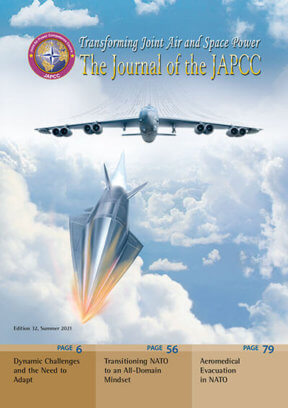Refocus on Joint and Combined
Joint All-Domain Operations (JADO) is a concept with the ambition of maximizing the effectiveness of all declared NATO forces through broadly focusing on two critical interoperability areas: obstacles between services and across the nations. The overarching goal of JADO is to progress from coordinated joint actions (today’s capability) to synchronized all-domain operations. Considering that there are 30 NATO member countries, the Alliance has somewhere around 90 separate national services, each having their own identity, culture, and capabilities. Any effort that receives input from more than one of these 90 different services while making headway on improving interoperability across the Alliance should be considered. Historically, there has been a long list of warfighting philosophies designed to achieve progress in employing service-specific forces in a cohesive manner across two or more domains. Previous examples of efforts to expand ‘joint warfare’ concepts include ‘Air-Land Battle’1, ‘Air-Sea Battle’2, ‘Effects Based Approach to Operations (EBAO)’3, Net Centric Warfare, and most recently both ‘Air Land Integration (ALI)’ and ‘Multi-Domain Operations (MDO)’. MDO has established a foothold within the minds of NATO’s military thinkers, because it begins to examine the enormous potential of a truly integrated future joint force, able to simultaneously tap into capabilities across the entire spectrum of current and emerging systems available from military services. MDO has been described as ‘joint warfare on steroids’, making a reference to the number and speed of decision-making as compared to traditional joint warfare.
If embraced by joint leaders across NATO nations, MDO-focused efforts may create more interoperability throughout the approximate 90 services. There are, however, a few foundational issues with this joint effort that can be easily rectified. First, because essentially most services already operate across multiple domains, senior leaders who don’t believe MDO is a new idea or required for joint growth have been heard to essentially say, ‘Yes, I love multi-domain operations. We have been doing that in the Navy (or Marines, Army, Air Force) for decades and find it to be very effective.’ Second, although the approach of categorizing warfare actions into domains may have been historically appropriate, considering the entanglement of systems and interconnected capabilities spanning the domains in today’s state-of-the-art militaries, it can be argued that the traditional rigid structure of services based on their principle operating domain may not be very useful in many future scenarios. It is likely that the victor will emerge as the force able to manoeuvre easily in and through all domains in an efficient and synchronized manner at a speed which the opponent cannot match. Finally, since the vast majority of global militaries plan for and rely on their ability to conduct operations in a coalition environment, as is certainly the case for NATO-aligned nations, operating combined should be at the centre of the effort. In support of these tenets for the future of NATO operations, the ‘NATO JADO’ project has been introduced by the Joint Air Power Competence Centre (JAPCC). The current working definition for this term is:
NATO Joint All-Domain Operations: Actions taken by the joint forces of two or more NATO nations, comprized of all available domains, integrated in planning and synchronized in execution, at a pace sufficient to effectively accomplish the mission.
As previously discussed and implied in the title, the focus of this effort is joint and combined. Another joint focused effort, led by the United States (US) called Joint All-Domain Command and Control (JADC2) has recently decided to modify their title by adding ‘Combined’ to the front, updating the effort to CJADC2.4 Considering the way each service (and even platforms within each service) has built their data architecture, it may take a decade to achieve seamless Command and Control (C2) of only US assets, however the change in name is important. Adding ‘combined’, even if only initially in small groups of nations, helps keep the ultimate goal in sight as small advances in all-domain operations are attained.
Deterrence has been effective thus far for the Alliance. In the 72 years since the establishment of NATO, the Alliance has not faced a true existential challenge. There have been numerous cases of ‘coalitions of the willing’ engaging in combined campaigns which have identified many lessons. Building alliances has proven to be critical to successfully responding to a crisis in that it confers legitimacy on the effort while also increasing available forces and capabilities, reducing each nation’s individual burden. However, responding multilaterally creates challenges across the entire spectrum of the effort, from planning through execution and evaluation. Common issues include: maintaining proper alignment of the coalition and national priorities, asymmetries in the allocated forces in terms of technology and capabilities, operating with shared (or at least interoperable) Tactics, Techniques, and Procedures (TTPs), ironing out national caveats, determining a sound structure for C2, managing language barriers, and religious and cultural differences. Compounding the challenge, these obstacles can be even more difficult to quickly overcome when the coalition is required to coalesce and respond in a rapid manner due to an emerging crisis. NATO leaders should ensure that preparation for future operations is strongly influenced by this reality.
Training All-Domain Leaders
To develop operational leaders who are truly able to command with an all-domain perspective, joint training and education should start early in their careers. A leader who has spent the majority of their military employment tackling problems from a component-specific view of assets may find adapting their thinking to an all-domain mindset very challenging. In order to eliminate these biases in problem-solving, future JADO commanders might not be affiliated with a specific service at all. Even without knowing with much granularity what NATO JADO will look like, it is clear focus should be given to improve the ‘joint experience/expertise’ of leaders. Building these leaders at a young age, they will be better prepared to lead as portions of the NATO JADO concept begin to become operational reality. Just as essential to the conduct of operations in a future crisis will be the fundamental understanding of the multi-domain nature of NATO’s future forces. This will require the Alliance to educate, train and exercise forces in scenarios which promote all-domain understanding across the force and challenge traditional barriers to interoperability. The complexities of all-domain warfare will drive future leaders to have to increasingly rely on field commanders and operators to execute a variety of ‘mission-type’ orders while adapting to battlefield conditions as the conflict progresses and non-domain specific challenges and opportunities present themselves.
All-Domain Operational Execution
How can NATO continue to pivot towards considering effects across the domains? A step in the right direction might be to fortify the Joint Force Commands (JFCs) and their role in the planning and execution of large, joint operations. Over the past eight years, the JAPCC has been involved in the major NATO joint exercises and has contributed to the evolution of threat scenarios and dramatically improved the realism and complex nature of multi-domain warfare. Leaders and staffs across NATO have come to accept much more challenging situations along with embracing lessons identified through failure. These are very important advances along the path to improving and modernizing the mindset of NATO’s leaders when it comes to joint operations. Exercise Control is providing the training audience multi-domain warfare problems, and leaders are embracing this challenge.
However, progress in this evolution of thinking has been hampered by the use of historical component-specific problem-solving. An example of where this mindset needs to mature, is to consider the problem of trying to apply effects in an area that is highly contested, at least to some degree, in all-domains (sometimes referred to as Anti-Access/Area Denial or [A2/AD]). The adversary must employ highly capable systems across multiple domains to create this environment, and as such, it generally requires allied effects across all-domains to effectively gain access. However, JFCs have generally kept a more traditional approach, handing over the lead in this truly joint problem to a single component command. Component commands are experts in their component capabilities and have direct access to only their assets. Without the resident cross-domain knowledge and the large number of liaisons located at the JFC, component commands may not have the requisite insight into the capabilities and capacity of other components operating in the area. Although the supported commander is able to request support from the supporting components, there exists a tendency to use the assets under their control first, even if they are not the most effective for the specific mission. One step to begin training to an all-domain fight would be to favour the joint commander keeping primary responsibility for tasks that require a wide range of joint assets to achieve success.
Perhaps the solution involves a more tailorable command structure that considers the primary variables for a specific conflict. Depending on the conflict scenario (scale and complexity), the actual forces which have been allocated, and the level of joint training and experience the joint and component commanders (and their staffs) possess, asset apportionment and allocation could reside at various levels within the command structure. This more flexible command construct will likely challenge current views of supported and supporting relationships, and leaders should ensure the resulting command structure retains clear unity of command while maintaining focus on the strategic goals.
Synchronizing Joint Capabilities
NATO continues to develop joint capabilities, but still suffers from only being able to achieve ‘coordinated joint actions’ and not ‘synchronized all-domain operations’. While this is partially a function of the limits of the current C2 systems and structures, there is much more evolution possible in the ‘mindset and leadership’ areas. The JAPCC’s new NATO JADO study will evaluate process improvements for air operations to address the limitations in C2, leadership models, joint force training and information sharing. As technologies continue to improve and are more widely fielded across the Alliance, NATO leadership and training models must be poised to take advantage of these warfighting advances. With finite resources, generally characterized as stagnant for the majority of NATO nations, it is vitally important that decision makers maintain strong connection to the needs of their troops and concentrate their efforts on achievable projects that directly get after the most impactful solutions. The wide capability disparities between the 30 NATO nations are a challenge to the Alliance’s interoperability, but not an insurmountable barrier on the path toward NATO JADO. The key to mitigating the variations in national resources and military capabilities will be JADO training and education which should begin immediately. In addition, the impact of disparities in JADO competencies across the nations going forward can be lessened by a robust education and exercise regimen to test proposed leadership models and develop solutions to training deficiencies and improve decision speed.
Lessons Identified
The goal of combined, all-domain operations is a lofty one, especially when applying it to a large, NATO-led effort. However, through a plethora of nationally-directed efforts and exercises, lessons have already emerged that should be collectively incorporated into the Alliance to continue progression. One lesson theme identified has been the requirement to incorporate joint and partner considerations early in the development of national systems. Additionally, NATO needs to clearly define standards to avoid future interoperability issues while antiquated systems should be upgraded or replaced, if they cannot meet the standards. The majority of resources should be given to efforts that have matured to a state where tangible results can be produced. For example, there has been ample discussion about what future joint doctrine may look like in terms of who approves actions and who has control authority over assets. However, NATO’s current joint doctrine is able to broadly support JADO, and until more tests and exercises are conducted, efforts may be better served on known JADO deficiencies such as the establishment of a robust C2 system, able to link sensors to shooters across organizations. Emphasis on development of advanced C2 should be prioritized now, instead of waiting for updates to the doctrinal hierarchy. Furthermore, joint exercises have unequivocally concluded that JADO requires a high level of decentralized execution to be efficient. Considering the trend in many militaries over the last few decades which could be characterized as moving towards more centralized control, the question remains if current TTPs are able to support an expansion of decentralization or indicate the need for a modification. Additionally, NATO’s existing standardization protocols, each nation’s budget realities and support to national industries, and the uneven distribution of advanced technologies will continue to challenge interoperability efforts and promote the lop-sided allocation of burdens across the Alliance. To fully mitigate these factors, it will be necessary to reimagine the supported and supporting relationships in joint warfare settings.
Conclusion
The ability of NATO forces to be seamlessly interoperable, complementary, and harmonized will be required to prevail against potential future peer adversaries while minimizing allied losses. Considering the rapid advance of technology and capabilities worldwide, their uneven distribution, along with the relatively recent expansion of warfighting domains (space and cyberspace), the requirement for NATO to learn how to operate synergistically across all-domains is clear. If, in this process, it is concluded that it is too difficult to combine 90 disparate organizations to fight cohesively, consider the situation where potential adversaries outpace NATO in the effort to evolve to an all-domain force. This is likely the most demanding military problem allied-nations and NATO will face, and all must act collectively and urgently to meet the challenge.













